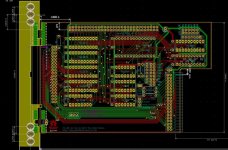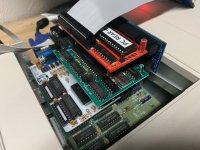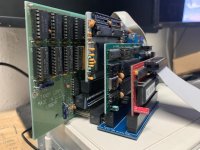blackepyon
Veteran Member
Yeah, I'd definitely recommend the '245 for the CF card section, because that thing gets very finicky, if you saw my post a few pages back on my protoboard CF-IDE.
Speaking of Tetris, this is the PLUS version of Glitch's XT-IDE that I've been working on (I got his permission, it's open source anyways). Also adding a couple things of my own.

MediaFire link here if that's too blurry
This is still a work in progress, once I can get back to it. I was doing fine tuning and confirming my measurements, but now that I know how far the transformer from the modem card goes, I'm debating whether or not to pull the first two chips on the left inwards about .200" to clear the transformer.
It is time consuming to "play Tetris" with a PCB, but very doable if you're patient.
I find that you can get quite a lot into a small space by running horizontal traces on one side of the board, and vertical traces on the other. It also assumes you're not being charged by the number of drill holes, because it involves a lot of vias.
And yes, there's two IDE headers. Same controller, but I wanted to have the option of having one end exposed to the back for an external drive, or to quickly plug in a CF card sled and transfer files to whatever is installed internally. The big exposed copper piece on the left is to be a separate piece of PCB to solder on at a right angle to form the back panel.
Speaking of Tetris, this is the PLUS version of Glitch's XT-IDE that I've been working on (I got his permission, it's open source anyways). Also adding a couple things of my own.

MediaFire link here if that's too blurry
This is still a work in progress, once I can get back to it. I was doing fine tuning and confirming my measurements, but now that I know how far the transformer from the modem card goes, I'm debating whether or not to pull the first two chips on the left inwards about .200" to clear the transformer.
It is time consuming to "play Tetris" with a PCB, but very doable if you're patient.
I find that you can get quite a lot into a small space by running horizontal traces on one side of the board, and vertical traces on the other. It also assumes you're not being charged by the number of drill holes, because it involves a lot of vias.
And yes, there's two IDE headers. Same controller, but I wanted to have the option of having one end exposed to the back for an external drive, or to quickly plug in a CF card sled and transfer files to whatever is installed internally. The big exposed copper piece on the left is to be a separate piece of PCB to solder on at a right angle to form the back panel.





